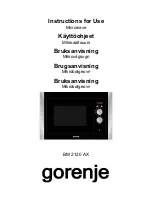
22
Cooking Charts
18
Cooking Charts
When using the
defrost weight
feature, the weight
entered should always be (valid entries are from 4 to 100
ounces).
Use both
defrost weight
and
defrost time
features for
raw food items only. Defrosting gives best results when
food to be thawed is a minimum of 0°F (taken directly
from a true freezer). If the food has been stored in a
refrigerator-freezer that does not maintain a temperature
of 5° F or below, always program a lower food weight or
lower cook time to prevent cooking the food.
If the frozen food is stored outside the freezer for up to
20 minutes, enter a reduced cook time or weight.
The shape of the package will alter the defrosting time.
Shallow rectangular food packets defrost more quickly
than a deep frozen block of food.
Separate pieces as they begin to defrost. Separated
frozen pieces of food defrost better.
Shield warm areas of food with small pieces of foil if they
start to become warm.
You may use small pieces of aluminum foil to shield food
items like chicken wings, leg tips and fish tails, but do not
allow the foil to touch the oven cavity walls when
defrosting.
Defrosting suggestions for meats
For best results, please read these suggestions when defrosting meats..
Defrosting tips
Meat
Normal amount
Suggestions
Roast beef or pork
2.5 to 6 lbs.
(40 to 96 oz.)
Start with the food placed fat side down. After each stage, turn the food
over and shield any warm portions with narrow strips of aluminum foil.
Let stand, covered for 15-30 minutes.
Steaks, chops or fish
0.5 to 3 lbs.
(8 to 48 oz.)
After each stage, rearrange the food. If there are any warm or thawed
portions of food, shield them with narrow flat pieces of aluminum foil.
Remove any pieces of food that are nearly defrosted. Let stand,
covered for about 5 to 10 minutes.
Ground meat
0.5 to 3 lbs.
(8 to 48 oz.)
After each stage, remove any pieces of food that are nearly defrosted.
Let stand, covered with foil for 5 to 10 minutes.
Whole chicken
(40 to 96 oz.)
2.5 to 6 lbs.
Remove giblets before freezing poultry. Start defrosting with the breast
side down. After the 1st stage, turn the chicken over and shield any
warm portions with narrow strips of aluminum foil. After the 2nd stage,
again shield any warm portions with narrow strips of aluminum foil. Let
stand, covered, for 30 to 60 minutes in the refrigerator.
Chicken pieces
0.5 to 3 lbs.
(8 to 48 oz.)
After each stage, rearrange or remove any pieces of food that are
nearly defrosted. Let stand for 10-20 minutes.
Meat
Normal amount
Suggestions
Roast beef or pork
2.5 to 6 lbs.
(40 to 96 oz.)
Start with the food placed fat side down. After each stage, turn
the food over and shield any warm portions with narrow strips of
aluminum foil.
Let stand, covered for 15-30 minutes.
Steaks, chops or fish
0.5 to 3 lbs.
(8 to 48 oz.)
After each stage, rearrange the food. If there are any warm or
thawed portions of food, shield them with narrow flat pieces of
aluminum foil.
Remove any pieces of food that are nearly defrosted. Let stand,
covered for about 5 to 10 minutes.
Ground meat
0.5 to 3 lbs.
(8 to 48 oz.)
After each stage, remove any pieces of food that are nearly
defrosted.
Let stand, covered with foil for 5 to 10 minutes.
Whole chicken
2.5 to 6 lbs.
(40 to 96 oz.)
Remove giblets before freezing poultry. Start defrosting with the
breast side down. After the 1st stage, turn the chicken over and
shield any warm portions with narrow strips of aluminum foil. After
the 2nd stage, again shield any warm portions with narrow strips
of aluminum foil. Let stand, covered, for 30 to 60 minutes in the
refrigerator.
Chicken pieces
0.5 to 3 lbs.
(8 to 48 oz.)
After each stage, rearrange or remove any pieces of food that are
nearly defrosted. Let stand for 10-20 minutes.




































